Let’s face it, you probably don’t spend much time thinking about your pinky toe. But when injury strikes, it might be the only thing on your mind! There are many reasons why your pinky toe might be causing you more trouble than normal. Read on for some common issues and when it’s best to get professional treatment.

Fracture
If you’ve stubbed your pinky toe, dropped something heavy on it, or hit it during contact sport and are injured, you may have broken your toe. Breaks can be complete, or they could be stress fractures, meaning the bone has developed tiny cracks. If you’ve got swelling, pain, stiffness, or injury to your nail, you may have a break. It’s very important you get your toe assessed by a podiatrist if you have these symptoms and if they start to worsen.
Dislocation
If you’ve knocked your toe or overstretched it, the bones may have separated and you could have a dislocation. Dislocations can be partial or complete, and commonly cause pain on movement, swelling, bruising, and numbness. Your toe will also look crooked, which is often a tell-tale sign of dislocation. If you suspect a dislocation in your pinky toe, contact us today.
Sprain
Sprains arise from injuries to ligaments, which connect bones and joints. They’re often caused by hard knocks or overstretching. If you have a sprain, you’ll have pain but will usually be able to keep walking. You may also notice throbbing, tenderness, swelling, or bruising. A podiatrist can correctly assess the severity of your sprain and provide or recommend the appropriate treatment.
Tailor's bunion or bunionette
If you notice a bony bump at the base of your pinky toe, you might have a tailor’s bunion or bunionette. These can be caused by abnormal foot structure, or by wearing shoes that are too narrow for your feet. If you have a bunion, you’ll notice a small lump that grows over time and appears red and swollen. You’ll likely also have pain, which can be significant. When you visit a podiatrist, they’ll be able to offer treatments to relieve your pain and advise on what you can do to maintain comfort.
Corns
Corns are made up of toughened layers of skin and generally arise as a response to pressure or friction. The most common cause is wearing shoes that are too tight or put too much pressure on your feet. Hard corns can cause pain, which can become worse if your shoe irritates it. You’ll likely be able to tell if you have a corn if you notice a tough, yellowing patch of skin that’s sensitive to touch and if you have pain when wearing your shoes. Podiatrists are trained to successfully alleviate the pain and discomfort associated with corns.
Get in touch
Don’t endure toe pain in silence. Contact Swan Podiatry and Orthotics today. We proudly offer a range of quality, affordable treatments to our valued Darwin clients. Call us on 0428 976 360 and get your feet feeling fantastic again!
Author

Cable Mills
Cable Mills is the Senior Podiatrist at Swan Podiatry and Orthotics in Darwin.
He studied Podiatry at Charles Stuart University and has worked in busy podiatry practices in Darwin and Melbourne since graduating in 2011. He has a passion for sport and biomechanics and finds it rewarding to be able to make a difference to people’s lives.
Cable opened the first practice of Swan Podiatry and Orthotics at the beginning of 2016. His areas of expertise are sports injuries, orthotic therapy, general treatment, nail surgery, fracture management and diabetic care.








